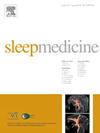失眠症患者1HZ重复经颅磁刺激后动态功能网络连通性的重构。
IF 3.8
2区 医学
Q1 CLINICAL NEUROLOGY
引用次数: 0
摘要
目的:本研究的目的是研究失眠患者大规模脑网络之间的动态功能连接,并评估重复经颅磁刺激(rTMS)治疗这些个体的疗效。方法:采用62例失眠症患者和69例健康对照者的静息状态功能磁共振成像(rs-fMRI)数据,比较两组动态功能连通性的差异。共有26名失眠症患者接受了为期四周的rTMS治疗。治疗后观察到失眠患者动态功能网络连通性的变化。此外,采用拓扑分析和相关分析分析临床症状与失眠的关系。结果:我们的研究结果表明,失眠患者的背侧默认模式网络(dDMN)和视觉网络(VN)之间的负连接率明显低于健康对照组,而视觉网络和听觉网络(AUN)之间的正连接率明显高于健康对照组。这可能是由于失眠患者经颅磁刺激后dDMN和VN之间恢复了正常的动态功能连接。此外,dDMN和VN之间的动态功能连接被发现可以预测失眠患者的睡眠质量和治疗结果。结论:dDMN与VN之间的动态功能网络连接异常是失眠的标志,可作为评估rTMS治疗失眠患者效果的生物标志物。本文章由计算机程序翻译,如有差异,请以英文原文为准。
Reconfigurations of dynamic functional network connectivity after 1HZ repetitive transcranial magnetic stimulation in insomnia disorder
Aims
The objective of the current study was to investigate the dynamic functional connectivity among large-scale brain networks in patients with insomnia, and to assess the efficacy of repetitive transcranial magnetic stimulation (rTMS) treatment in these individuals.
Methods
Resting-state functional magnetic resonance imaging (rs-fMRI) data from 62 insomnia patients and 69 healthy controls were used to compare differences in dynamic functional connectivity between the two groups. A total of 26 insomnia patients underwent rTMS for four weeks. Changes in dynamic functional network connectivity was observed in insomnia patients following treatment. Additionally, the relationship between clinical symptoms and insomnia was analyzed using topological and correlation analyses.
Results
Our findings demonstrated that insomnia patients exhibited a significantly lower fraction rate of negative connectivity between the dorsal default mode network (dDMN) and the visual network (VN) compared to healthy controls, while showing strong positive connectivity within the VN and the auditory network (AUN). It may be attributed to the restoration of normal dynamic functional connectivity between the dDMN and VN in insomnia patients following rTMS. Furthermore, the dynamic functional connectivity between the dDMN and VN was found to predict sleep quality and treatment outcome in insomnia patients.
Conclusion
Abnormal dynamic functional network connectivity between the dDMN and VN is a hallmark of insomnia, and may serve as a biomarker to assess the effects of rTMS treatment in insomnia patients.
求助全文
通过发布文献求助,成功后即可免费获取论文全文。
去求助
来源期刊

Sleep medicine
医学-临床神经学
CiteScore
8.40
自引率
6.20%
发文量
1060
审稿时长
49 days
期刊介绍:
Sleep Medicine aims to be a journal no one involved in clinical sleep medicine can do without.
A journal primarily focussing on the human aspects of sleep, integrating the various disciplines that are involved in sleep medicine: neurology, clinical neurophysiology, internal medicine (particularly pulmonology and cardiology), psychology, psychiatry, sleep technology, pediatrics, neurosurgery, otorhinolaryngology, and dentistry.
The journal publishes the following types of articles: Reviews (also intended as a way to bridge the gap between basic sleep research and clinical relevance); Original Research Articles; Full-length articles; Brief communications; Controversies; Case reports; Letters to the Editor; Journal search and commentaries; Book reviews; Meeting announcements; Listing of relevant organisations plus web sites.
 求助内容:
求助内容: 应助结果提醒方式:
应助结果提醒方式:


